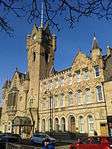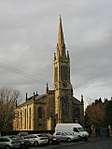Shawfield Stadium
Shawfield Stadium is a greyhound racing venue in the Shawfield district of the town of Rutherglen, South Lanarkshire, Scotland, located close to the boundary with Glasgow.[1]
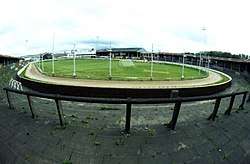 View from the terracing | |
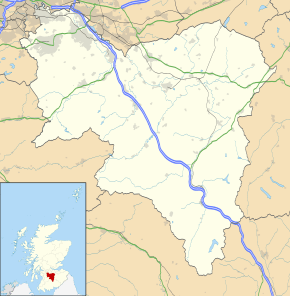 Shawfield Stadium Location in South Lanarkshire | |
| Location | Rutherglen Road Rutherglen, Glasgow G73 1SZ, Scotland |
|---|---|
| Coordinates | 55°50′18″N 4°13′44″W |
| Surface | Grass |
| Opened | 1898 |
| Tenants | |
| Clyde F.C. (1898–1986) Bridgeton Waverley F.C. (1923–1927) Glasgow Tigers (1988-1995, 1997-1998) Scottish Monarchs (1996) | |
It has also previously been a regular venue for football and speedway, as home to Clyde F.C. and the Glasgow Tigers respectively. Other sports including boxing and athletics has also been staged there.
From 1997, the stadium has been the only Greyhound Board of Great Britain (GBGB) greyhound track still in use in Scotland . It has hosted the Scottish Greyhound Derby since 1989, as it did from 1970 to 1985.
Greyhound Racing
Competitions
Opening
John Bilsland (sole owner of Stanley in Liverpool) helped instigate the plans to open Shawfield in his home town and brought the greyhounds to the home of Clyde F.C.. The football club had been based at the stadium since it opened in 1898[2] but were experiencing financial difficulties by 1930 resulting in the need to find new income streams. The club had tried previously to allow greyhound racing to take place at Shawfield but the Football league was opposed to the idea. Finally an agreement was reached with the chairman John McMahon and the Shawfield Greyhound Racing Company Ltd (SGRC) was born. [3] The track opened on 14 November 1932 in the North Rutherglen area of Glasgow and was a big galloping circuit of 473 yards with 125 yard straights with well banked bends and it became a very popular venue. When Shawfield opened for racing the city of Glasgow already hosted four other National Greyhound Racing Society affiliated tracks in Albion, Carntyne, White City and Firhill. In addition there were the independent tracks of Clydeholm, Coatbridge and Mount Vernon which totalled eight tracks in Glasgow at the time. [4]
The first recorded winner was 'Swordmanship' receiving six yards in a 303-yard handicap race, the time was 18.45 sec. The SGRC bought the stadium from Clyde FC in 1935. [5]
History
After the war had finished the SGRC was valued at £4,000 in 1946 by the taxman but the figure proposed by the owners was only £600 resulting in a dispute. As with most tracks at the time Glasgow experienced a profitable spell during the early fifties but both Albion and Firhill were closed to greyhound racing by the end of the decade. White City had shut by 1962 and in 1968 Carntyne was the latest track to close their doors which had a knock on effect for Shawfield. With the Scottish Greyhound Derby left without a home there were only two tracks big enough to host the event, Powderhall Stadium or Shawfield. The copyright of the Scottish Derby was held by the Greyhound Racing Association (GRA) and they decided that Shawfield could host the 1970 Scottish Derby. Jim Layton was Racing Manager at the time and one year later the track also received another prestigious former Carntyne competition called the St Mungo Cup. [6]
In 1975 a devastating fire at the track resulted in the loss of the majority of facilities for the public. To combat this an investment program that included a state of the art totalisator system, ray timing and photo finish equipment was planned and this period also saw the GRA arrive on the scene as they acquired the track under their GRA Property Trust. The track made the National Intertrack final in 1976. [7]
In 1983 the track came on the open market, Clyde FC were given notice to leave in 1986 and the stadium shut down on 25 October 1986. Supporters of the track lobbied to save the track and with the help of Billy McAllister, a former bookie, Racing Manager and racing reporter at the track, the Shawfield Action Group was formed. An 8,000 strong petition helped stave planning permission and there was some good news when a business consortium bought the track instead of the expected developers. On 11 June 1987 the track re-opened under the Shawfield Greyhound Racing and Leisure Company Ltd. [8] In 1988 the GRA lost their rights to the Scottish Derby following the sale of Powderhall and the Scottish Derby returned to its Glasgow roots. The management which included Robert Lithgow (Racing Manager), had already re-introduced the St Mungo Cup and William King Cup. A £100,000 facelift completed the takeover.
The large tote board which dominated the south end of the track was demolished in 2004 and the track today is the only remaining licensed track in Scotland. [9]
Track records
Current records
| Distance (metres) |
Greyhound | Time | Date | Notes |
|---|---|---|---|---|
| 300 | Ravage Again | 17.35 | 07.04.1990 | |
| 480 | Droopys Buick | 28.63 | 02.04.2016 | |
| 500 | Droopys Sandy | 29.39 | 21.05.1994 | Scottish Greyhound Derby Final |
| 500 hurdles | Face The Mutt | 31.07 | 25.05.1982 | |
| 670 | Crack of the Ash | 40.50 | 11.09.1993 | |
| 730 | Decoy Princess | 45.09 | 20.02.1988 | |
| 882 | Rosemoor Flower | 56.55 | 13.04.2002 | |
| 932 | Silken Dancer | 59.35 | 02.09.1993 |
Pre Metric records
| Distance (yards) |
Greyhound | Time | Date | Notes |
|---|---|---|---|---|
| 300 | Montforte Louis | 16.45 | 30 July 1965 | |
| 300 | Bright Lad | 16.60 | 27.05.1970 | |
| 500 | Clane Flirt | 27.88 | 06.08.1945 | |
| 550 | Rushton Smutty | 27.60 | 16.07.1951 | |
| 525 | Fin Machree | 29.07 | 21.07.1947 | |
| 525 | Biddys Fire | 28.75 | 27.07.1964 | |
| 535 | Killone Flash | 29.63 | 10.05.1971 | |
| 700 | Mad Midnight | 39.88 | 1946 | World Record |
| 700 | Our Tansy | 39.53 | 12.07.1947 | |
| 500 H | Minorcas Glass | 28.75 | 18.05.1956 | |
| 525 H | Morganstown View | 30.30 | 08.08.1958 |
Post Metric records
| Distance (metres) |
Greyhound | Time | Date | Notes |
|---|---|---|---|---|
| 300 | Fearless Prince | 17.97 | 1987 | |
| 300 | Movealong Inler | 17.94 | 20.02.1988 | |
| 300 | Ravage Again | 17.41 | 27.10.1989 | |
| 450 | Fair Hill Boy | 26.85 | 27.10.1989 | |
| 480 | Comrades Delight | 29.56 | 21.12.1991 | |
| 480 | Funny Enough | 29.32 | 10.09.1994 | |
| 480 | Solar Symphony | 28.97 | 20.05.1995 | Scottish Greyhound Derby Final |
| 480 | Justright Melody | 28.87 | 08.08.1995 | |
| 480 | Farloe Verdict | 28.79 | 03.04.2004 | Scottish Greyhound Derby Final |
| 480 | Fear Haribo | 28.76 | 14.04.2007 | Scottish Greyhound Derby Final |
| 480 | Tyrur Kieran | 28.69 | 09.04.2008 | Scottish Greyhound Derby semi final |
| 480 | Greenwell River [11] | 28.66 | 11.04.2009 | Scottish Derby invitation |
| 500 | Special Account | 10.08.1982 | Scottish Greyhound Derby semi final | |
| 500 | Special Account | 29.99 | 14.08.1982 | Scottish Greyhound Derby Final |
| 500 | Westmead Harry | 29.62 | 19.05.1990 | Scottish Greyhound Derby Final |
| 510 hurdles | Lovely Pud | 31.63 | 09.07.1984 | |
| 670 | Prince Peacock | 41.53 | 11.08.1984 | |
| 670 | Wellimoff | 41.08 | 1988 | |
| 670 | Chicita Banana | 40.83 | 07.04.1989 | |
| 725 | Woopsy | 45.91 | 1987 | |
| 882 | Omega Jet | 56.63 | 18.04.1998 | |
| 882 | Lucky Mollie | 56.55 | 13.04.2002 | |
| 882 | My Tootsie | 60.44 | 1987 | |
| 932 | Denes Mutt | 59.68 | 08.09.1987 | |
| 932 | Swiss Trips | 59.54 | 05.09.1991 |
Football
Clyde F.C. took over the site, previously a trotting track, in 1898,[12][2] having previously been based across the River Clyde at Barrowfield Park. The club earned additional revenue from using Shawfield for boxing and Track and field; greyhound racing was introduced in 1932.[12] Clyde's financial difficulties led to the sale of Shawfield to the Shawfield Greyhound Racing Company Ltd in 1935, but the club continued to play there as tenants.[12] They invited emerging Junior team Bridgeton Waverley to play there temporarily in the 1920s.[13] During the Second World War, Clyde almost had to leave Shawfield because the owners demanded the use of the stadium on Saturday afternoons.[14][15] Eventually a compromise was reached where the stadium would be used for dog racing on alternate Saturday afternoons, allowing Clyde to play their home fixtures.[15]
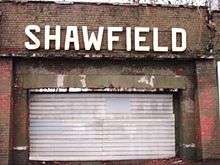
After World War II, Clyde and the other smaller clubs in the Glasgow area struggled to compete with the dominant Old Firm.[16] In addition to this, many of the heavily populated tenements surrounding Shawfield (Oatlands, Hutchesontown, Dalmarnock, Bridgeton and central Rutherglen districts) had been cleared in the 1960s, reducing Clyde's support base.[12][17] The club proposed to move to the new town of East Kilbride in 1966.[12] Four years later, Clyde attempted to take over Hamilton Academical;[18] this collapsed when four of the Hamilton directors secured a lease on Douglas Park.[18] Clyde continued to play at Shawfield until 1986, when the GRA's redevelopment plans led to Clyde's eviction.[12] Despite the collapse of the redevelopment plans, Clyde did not return to the ground, although this was proposed in 1988.[12] After a period of uncertainty playing at Firhill in the north of Glasgow (home of rivals Partick Thistle) and then later at Hamilton, Clyde eventually accepted an offer from the town of Cumbernauld to move to what became Broadwood Stadium.[12]
Notable matches
The stadium hosted four Scottish Football League XI representative matches:[19] in 1911 versus the Southern League,[20] 1921 versus the Irish League XI,[21] and 1954 and 1956 versus the League of Ireland XI;[22][23] the Scottish side won all four matches. An international trial match between a Scotland XI and the British Army was played in 1955.[24]
The venue also hosted the annual Glasgow vs Sheffield Inter-City match in 1901, 1954, and 1956.[25] Harry Haddock and Tommy Ring both played in the two latter matches, with Ring also scoring in both. The Scotland under-23 team hosted the Auld Enemy in 1955.[26]
It also hosted three Scottish Junior Cup Finals, in 1909, 1942 and 1943 (two of these went to a replay, held elsewhere).[27] Additionally, the Junior Central League Cup final between Ashfield and Kilsyth Rangers was played at Shawfield on 20 June 1953; Ashfield won 2–1 in front of a crowd of 7,000.[28]
1957 disaster
On 14 December 1957, a disaster occurred at the stadium during a Scottish Football League match between Clyde and Celtic.[29] A very large crowd of 27,000 had been allowed into the stadium to see the fixture[30] (involving the team which had just won the League Cup and the team which would go on to lift the Scottish Cup at the end of the season), with reports of the time describing Shawfield as "bursting at the seams";[31] crushing was experienced among some of the spectators prior to kick-off. At the time this issue was a fairly common occurrence at popular events, and it was also normal for children in the crowd to be passed over the heads of the adults out of the terracing. In this instance the juveniles were passed over the four-foot-high terracing boundary wall onto the greyhound track and sat on the track to watch the match, with their backs to the wall.[32][29]
In the opening minutes a goal by Celtic resulted in a surge forward among the packed crowd, and a section of the boundary wall collapsed forward under the strain, falling onto the boys sitting on its opposite side.[32][31][29] Players stopped to help the injured,[32][31] whilst supporters at the other end of the ground were unaware of any incident due to the smog which enveloped the stadium,[31] and initially shouted for the game to be restarted. The match did resume following a 20-minute delay to rescue trapped boys and carry away the injured for treatment, despite some of the players being visibly distressed by what they had witnessed.[33][32] Celtic eventually won a contest played at particularly high intensity by a 6–3 scoreline.[33]
A total of 50 persons were injured, almost all of them children, with 13 detained in hospital suffering serious injuries and one fatality among them: a nine-year-old boy named James Ryan from Bridgeton whose chest was crushed.[30][29]
During the Fatal accident inquiry the following February his uncle stated that James had been lifted over the wall onto the track only seconds before it collapsed,[29] and other boys who were injured also stated that they had still been in the stand at the time the goal was scored and had jumped over the wall to avoid being crushed just prior to it falling.[30] The inquiry heard evidence that the wall had been inspected following the incident and was of sound and legal construction, and it was only the extreme force that caused it to collapse.[30][29] The accident was blamed on unruly persons in the crowd who had repeatedly been rushing forward irresponsibly,[29] and on the absence of any crush barriers in that area of the terracing which would have lessened the forward pressure exerted.[30] The police also stated that they had not formally agreed for any persons to be on the track at the time (although it was permitted in exceptional circumstances), and even larger attendances had previously been recorded at Shawfield for fixtures against Celtic and Rangers.[30]
Speedway
The Glasgow Tigers, returning to their home city in 1988 after a year's exile in Workington, became the new tenants after Clyde FC. The Tigers raced there for a decade, apart from the 1996 season when they were temporarily in abeyance and replaced by the ill-fated Scottish Monarchs who had a team but no track due to the closure of Powderhall. When the venue opened, the racing could be viewed from two straights and the third and fourth bends but over the years the viewing area was reduced to a small part of the stadium in front of the stand. They departed to Ashfield Stadium ahead of the 1999 season.
Location anomalies
- Historically, the boundary between the City of Glasgow and the county of Lanarkshire passed right through Shawfield. During World War II, when the gathering of crowds in areas deemed "unsafe" were severely restricted, this meant Shawfield was allowed to accommodate 20,000 spectators, whereas Celtic Park, less than a mile away but wholly located in Glasgow was permitted only 10,000 people in a much larger venue.
- In the 1966–67 season, Clyde's third-placed finish in the Scottish League should have earned them a place in the Inter-Cities Fairs Cup, however a one club per city rule applied to the competition, and second placed Rangers had precedence to represent Glasgow. Clyde attempted to argue that Shawfield's location actually meant they were from the separate town of Rutherglen, however the organisers of the tournament cited Clyde's membership of the Glasgow Football Association and participation in the Glasgow Cup.
- Local government reorganisation in 1975 meant that Rutherglen, and Shawfield with it, was now incorporated entirely into an expanded Glasgow district within Strathclyde region. Further changes in 1996 created the new unitary authority area of South Lanarkshire, with Shawfield now lying entirely within this area and no longer even partially in Glasgow.
See also
- Scottish stadium moves
References
- "Track Search". Greyhound Board of Great Britain. Archived from the original on 25 December 2011. Retrieved 24 December 2011.
- Origins - Barrowfield Park - 1877-98 Clyde FC
- Genders, Roy (1990). NGRC book of Greyhound Racing, page 29. Pelham Books Ltd. ISBN 0-7207-1804-X.
- Barnes, Julia (1988). Daily Mirror Greyhound Fact File, page 132. Ringpress Books. ISBN 0-948955-15-5.
- Barnes, Julia (1988). Daily Mirror Greyhound Fact File, page 132. Ringpress Books. ISBN 0-948955-15-5.
- Genders, Roy (1981). The Encyclopedia of Greyhound Racing, pages 70-71. Pelham Books Ltd. ISBN 07207-1106-1.
- Genders, Roy (1990). NGRC book of Greyhound Racing, page 29. Pelham Books Ltd. ISBN 0-7207-1804-X.
- Barnes, Julia (1988). Daily Mirror Greyhound Fact File, page 132. Ringpress Books. ISBN 0-948955-15-5.
- Hobbs, Jonathan (2007). Greyhound Annual 2008, page 204. Raceform. ISBN 978-1-905153-53-4.
- "Track records". Greyhound Data.
- "Monthly Greyhound Star (Remember When 2009) April edition". Greyhound Star. 2012.
- Inglis 1996, p. 436
- "Bridgeton Waverley's Big Deeds". 'Junior Veteran'. Glesga Keelies. Retrieved 2 October 2017.
- (Bob Crampsey 1990, p. 97)
- (Bob Crampsey 1990, p. 115)
- (Bob Crampsey 1990, p. 182)
- "Club history: Post-war". Clyde F.C. Retrieved 5 October 2017.
- (Bob Crampsey 1990, p. 183)
- Player Representative Honours, Partick Thistle History Archive
- Mon 02 Oct 1911 SFL 3 Southern League 2, London Hearts Supporters Club
- Wed 26 Oct 1921 SFL 3 Irish League 0, London Hearts Supporters Club
- Thu 18 Nov 1954 SFL 5 League Of Ireland 0, London Hearts Supporters Club
- Wed 26 Sep 1956 SFL 3 League Of Ireland 1, London Hearts Supporters Club
- "Useful practice match for Scotland's team (page 11)". Glasgow Herald. 8 December 1955. Retrieved 29 July 2020.
- "Football. Inter-city Match–Glasgow V Sheffield". Glasgow Herald. 12 September 1901. Retrieved 7 August 2020.
"Remarkable Late Miss by Glasgow's Centre". Glasgow Herald. Partick Thistle History Archive. 11 November 1954. Retrieved 7 August 2020.
"GLASGOW VS SHEFFIELD – SHAWFIELD GLASGOW – INTER CITY MATCH – 14-NOV-56 – 1956/1957 – MINT". Your Football Programmes. Retrieved 7 August 2020. - "England's Matches the under 23's". England Football Online. Retrieved 7 August 2020.
- Scottish Junior Cup Finals, Scottish Junior Football Association
- "The Field in Clover (Front Page)". Evening Times. 20 June 1953. Retrieved 17 July 2020.
- "When tragedy struck at the football". The Herald. 23 December 2015. Retrieved 5 October 2017.
- "Fans at back caused sway". Evening Times (hosted on 'the Celtic Wiki'). 27 February 1958. Retrieved 5 October 2017.
- "It looked all over". Evening Times (hosted on 'the Celtic Wiki'). 14 December 1957. Retrieved 5 October 2017.
- "Shawfield Horror". Evening Times (hosted on 'the Celtic Wiki'). 14 December 1957. Retrieved 5 October 2017.
- "Great match at Shawfield". The Herald (hosted on 'the Celtic Wiki'). 16 December 1957. Retrieved 5 October 2017.
- Sources
- Bob Crampsey (1990). The First 100 Years. Scottish Football League. ISBN 0-9516433-0-4.CS1 maint: ref=harv (link)
- Inglis, Simon (1996). Football Grounds of Britain. Collins Willow. ISBN 0-00-218426-5.CS1 maint: ref=harv (link)
External links
| Wikimedia Commons has media related to Shawfield Stadium. |
- Official website
- Stadium and track info from dog-track.co.uk
- Photos of racing at Shawfield in 1955, from the Mitchell Library archive
